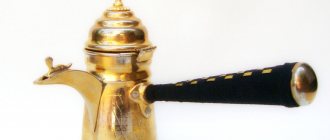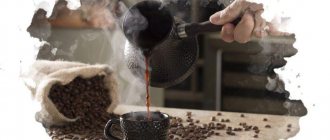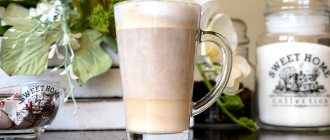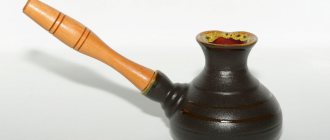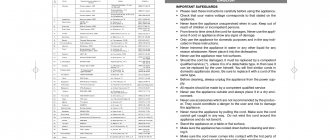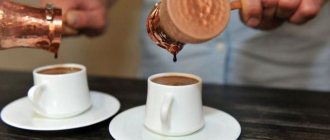Characteristics and beneficial properties of copper cookware
For many people, the sight of a copper basin polished to a shine can bring them back to a happy childhood and remind them of the unforgettable taste of the cherry jam their grandmother brewed in it. Others, at the sight of a copper Turk, will feel the taste of unsurpassed Turkish coffee. Today, copper cookware is again gaining extreme popularity and filling the shelves of china shops. But at the same time, the question arises about the dangers of using copper utensils.
Copper utensils
Possible harm and benefits of use
Pure copper, when it enters the human body, does not cause any damage to it, does not accumulate and is quickly eliminated. The benefits of copper cookware have been proven through many experiments. The bactericidal properties of copper utensils can destroy various types of influenza and the causative agent of many diseases - Staphylococcus aureus. A lack of this substance in the body can significantly affect health.
Copper cookware set
It is also worth paying attention to information about the possible harm from using copper and brass for cooking. Pure copper or brass when in contact with certain products may cause them to oxidize. Despite the fact that India is a leader in the use of copper utensils, it has been proven that for most infants, preparing formula in copper plates resulted in cirrhosis of the liver. This is due to the fact that the newborn’s liver cannot yet fully filter out harmful substances entering the blood and control the excess of useful ones. Therefore, when it enters the child’s body, it begins to accumulate, causing poisoning. For the same reason, people who abuse alcohol should not drink coffee made from brass or copper.
Considering the possible negative consequences, today copper cookware made in Russia and produced in other countries is manufactured with a special internal anti-stick Teflon and ceramic coating.
Copper pan
Secrets of choosing copper cookware
Before you make a purchase, you should weigh the pros and cons of using copper in the kitchen. The advantages of copper pans:
- durability and strength, with brass even being a little stronger,
- uniform heating,
- ease of maintenance and operation,
- taste of dishes,
- wide range of choice and design.
At the same time, it is worth knowing about the disadvantages:
- You should not leave such dishes wet, because excess moisture may cause a harmful film to appear on its surface - patina,
- the outer surface of a pan or stewpan that has not been used for a long time may darken,
- high price.
It is also worth knowing the difference between “copper cookware” and “copper coated cookware.” They differ significantly both in price and in the weight of the product. Another effective piece of advice would be the recommendation not to use cookware manufactured in India for preparing hot food. Indian production does not provide surface coating, and therefore such dishes are only suitable for cold dishes.
Dishes on the table
Using copper utensils correctly
In order not to spoil the expensive pan and the taste of the dishes, it is worth remembering the following operating rules:
- Forged cookware lasts the longest.
- Tinned dishes should only be used for cooking and stewing. While for frying it is necessary to purchase frying pans with steel and nickel coating.
- Brass is more suitable for making jam.
- Tinned dishes can only be cleaned with soda using soft scrapers.
- Pure copper requires more stringent care - regular cleaning with special pastes and polishes without chlorine.
- You cannot put an empty frying pan on the fire.
- Do not pour boiling water into dry dishes and add salt to the dish only after the water has boiled.
- It is forbidden to mix cooking food with metal spatulas.
- Do not wash copper cookware in dishwashers.
- Dry wet copper dishes only on racks upside down.
Drying dishes
A few words about the manufacturers
The production of copper cookware is a popular and highly profitable business today. Russian production is headed by Kolchugino. The Kolchuginsky plant is the largest manufacturer of high-quality copper cookware, which can not only decorate any kitchen, but also make food both tasty and healthy. Modern equipment allows you to create stylish, elegant and at the same time practical products that will serve their owners for many years. Russian production is also represented by “Azbuka Vkusa” and the “Basiliko” line.
Foreign manufacturers are represented by:
- French "De Bayer". The company is an exporter of copper products to 70 of the world's largest countries. Since their founding in the early 19th century, they have never stopped introducing new developments and improving quality.
- Japanese Supra. In addition to all kinds of equipment, not long ago Supra took up the production of copper cookware. For this purpose, a family factory of copper craftsmen, small in size, but not long in existence, was attached to the huge concern.
- Italian TVS. The products of this company can be found on store shelves anywhere in the world.
- Portuguese "Bioflon". has been in existence for more than 30 years, and during this time it has managed to become the largest manufacturer of copper cookware in Portugal.
The benefits and harms of copper cookware is a matter of concern to many people. But few people know that, along with copper utensils, lead in ceramics, stainless steel and aluminum pose a health hazard. It is also harmful to use cracked glassware and the now fashionable Teflon for cooking.
posuda.vyborkuhni.ru
More about harmful and “useful” dishes. Consequences.
In the article we will look at the possible “bad consequences” of eating food from metal, ceramic, glass dishes, as well as cookware with a non-stick coating. Valuable additions are welcome in the comments.
Tree
In Rus', dishes were originally made of wood. They ate with wooden spoons from wooden bowls, and used wooden bowls, ladles and jugs. In addition, they wove dishes from birch bark - salt shakers, containers for storing flour and cereals.
It is known that birch bark has many medicinal properties - from bactericidal to tonic. This is how the body of our ancestors gradually accumulated the healing properties of trees.
But it is important to take into account that wooden utensils painted with Khokhloma should not be used as food.
Copper
Copper utensils appeared next. Perhaps you also have a copper basin or saucepan in your kitchen? Indeed, in many families, dishes made of copper and its alloys are passed down from generation to generation. And no wonder: they always used it with pleasure! The fact is that, due to its high thermal conductivity, copper has a remarkable quality for cooking - heat is evenly distributed over the surface of the cookware. And therefore, delicious jam, aromatic coffee or a wonderful sauce are obtained in copper dishes as if by themselves.
But modern science somewhat dims our emotions - from its point of view, even a very small amount of this metal destroys ascorbic acid in berries and fruits.
And one more thing: food stored in copper dishes loses vitamins, polyunsaturated fatty acids in it are easily oxidized, forming compounds dangerous to the body - free radicals.
With its frequent use, poisoning is possible.
In addition, copper in a humid environment easily oxidizes and a green or blue-green film appears on the dishes - patina. When heated, it interacts with food acids, forming copper salts that are harmful to the body.
Therefore, after washing, the plate or basin must be thoroughly wiped, avoiding the formation of a film. If patina does appear, then before using the dishes it must be carefully removed from the entire surface. You can do this this way: wipe with table salt soaked in vinegar, and immediately rinse first with warm, then with cold water.
If you have copper utensils, we recommend that you read more about proper handling of them, unless, of course, you value your health. This is not the purpose of this article.
The dangers of lead in ceramic cookware
For centuries, lead was added to the alloys from which dishes were made. The sad consequences of this are now well known to scientists: lead, gradually accumulating in the human body, led to poisoning.
In the Roman Empire, wine vessels and other kitchen utensils contained large amounts of lead. As a result, the life expectancy of the population has decreased by almost half. Some historians even believe that lead poisoning of the Roman “elite” was not the last reason for the decline of the powerful state.
Also in our time, scientists have proven that lead is guilty of destroying the health of the Moscow princes - the water that was supplied to the Kremlin flowed through a lead water supply system...
In many countries around the world, more than a quarter of a century ago, a ban was introduced on the use of lead in the production of tableware. But despite this, even today you can easily become the owner of harmful pots or, for example, cups.
Here it is appropriate to recall the well-known story of an American couple.
Once, while vacationing in Italy, the couple bought beautiful ceramic cups. When they arrived home, they did not put them behind glass in the cupboard to admire and show to guests, but began to actively use them every day.
After two and a half years, both spouses began to show signs of lead poisoning: insomnia, nervous disorders, sudden attacks of pain “walking” through different parts of the body. The doctors to whom the sufferers turned were at a loss - they could not understand what was the matter.
The man even underwent two completely unnecessary surgeries, and the woman was persistently treated for liver disease.
But, following the well-known saying “saving drowning people is the work of the drowning people themselves,” the American couple, having “shoveled” through a mountain of specialized medical (and perhaps not only) literature, diagnosed themselves with lead poisoning! And he was absolutely correct, which was later confirmed by specialists working with poisons.
Let's try to figure out how lead got into the dishes (after all, the cups are ceramic, not metal!). It can be assumed that they were decorative, and therefore not intended for drinking tea, coffee and other drinks from them.
The fact is that, according to sanitary standards, the presence of lead in the manufacture of decorative dishes is allowed. It turns out that it is added to paints to give pottery smoothness and a beautiful shine. But: the instructions for using such utensils must clearly state that food cannot be stored in it!
Therefore, we draw a conclusion for ourselves: if we buy a brightly colored plate, cup, or pot that we like, don’t be shy and be sure to ask the seller for a certificate. And in this document we are looking for information about the results of testing dishes for toxic substances. But, unfortunately, the reality is that certificates are often counterfeited.
So, maybe it’s better to be careful and not buy ceramic products with too bright red and yellow painting, which almost always indicates the presence of lead and cadmium in the paint.
By the way, the bright green color may be “tinted” with copper. And besides being not useful in itself, it also speeds up the process of lead release. Therefore, it is not forbidden to purchase such cups and plates for beauty, but for everyday use for their intended purpose, experts categorically do not recommend them.
Lead in cans
In addition to dishes, some cans can also become a source of lead poisoning, since their elements are connected to each other with solder containing lead. Such cans are easily distinguished by their corrugated seam and silver-gray connecting line with irregular outlines. Although the inner surface of the cans is usually coated with a special compound, this does not always help.
There are known cases where up to 3 mg/kg of lead accumulated during long-term storage, which is much higher than the permissible level. Its content can be especially high in canned acidic foods: tomatoes, fruit juices, etc.
In order not to expose yourself to danger, you should buy canned food in tin cans with smooth welds that are located between the sticker and the upper or lower end of the can.
Aluminum
Aluminum cookware could be seen in almost every kitchen 10-15 years ago. It is easy to clean, and food does not burn in it when cooking. It’s very good to boil milk in such a saucepan, cook milk porridges, jelly, vegetables for vinaigrette and salad, etc. But, sadly, all this food turns out to be “flavored” with aluminum!
Both under the influence of milk, as a representative of alkali, and under the influence of the acidic environment of vegetables being cooked in microscopic doses, aluminum “peels off” from the dishes and safely ends up in our stomach. It does not oxidize in water, but even it “washes out” its microparticles.
So, if possible, you should neither cook nor store food in aluminum containers (although they are suitable for storing cereals and other bulk products, which, obviously, will not react with aluminum). Of course, if you cooked rolled oats porridge for your child in an aluminum ladle once or twice, nothing bad will happen. But if you do this every day, then don’t be surprised that the baby has become terribly excitable.
Well, if you cook for yourself in utensils made of this metal for years, then one of the existing hypotheses is this: sooner or later enough aluminum will accumulate in your body to provoke such serious diseases as anemia, kidney disease, liver disease, various neurological changes and even illness Parkinson's and Alzheimer's disease.
It is also not recommended to bake game, geese, or chicken in aluminum foil. At high temperatures in the oven, food is actively saturated with aluminum. It's worth serious consideration.
Melamine
Relatively recently, beautiful melamine dishes made in China and Turkey appeared in our kitchens. In appearance it resembles porcelain, but is much lighter in weight. Due to its very attractive appearance and purity of colors, it is popular among buyers.
But these dishes are toxic! One of the sources of danger is salts of lead (again!), cadmium and other metals that are part of the paints with which she paints.
Paints applied using the decal method are not coated with any protective layer, and they very easily get into the products.
Another danger is that melamine contains toxic formaldehyde. Many plastics emit it, but melamine, according to the results of special studies, does this especially strongly - tens or even hundreds of times exceeding the permissible limit. In experimental animals, such doses of formaldehyde cause mutagenic changes in the body and the formation of cancer cells.
The sanitary and epidemiological inspection banned the sale of melamine tableware. But go to the tableware department at any market and you will see cute cups, plates and all kinds of sets of them.
In addition to melamine, utensils made from other polymer metals can also be found on sale.
Specialists involved in testing and certification of this product believe that it can be used, but only with strict adherence to the manufacturer’s instructions.
For example, if plastic containers are intended only for bulk products, then liquids cannot be kept in them, otherwise they may absorb toxic substances. If the instructions for using, for example, plastic containers say that they are for cold food, then there is no need to put hot food in it, etc.
"Stainless steel" and silver
Recently, cookware made from stainless steel, an alloy of iron, carbon and other elements, has become very popular. Steel with additions of 18% chromium and 10 or 8% nickel is widely used for the manufacture of kitchenware. If it is made of high-quality steel (and the production technology is not violated), it does not change the taste of the food and is safe for health. The best grade of steel is 304 (or 18/10), somewhat worse are grades 201 and 202. Cheap stainless cookware from China, India, and other Asian countries can be of poor quality and even hazardous to health due to unwanted impurities. However, now it is successfully disguised as European...
Stainless steel pots and pans are preferred with thick bottoms - they provide gradual heating and long cooling. Stainless steel cookware should not be overheated - after this the food in it will burn.
This begs the question: is there such a thing as completely safe cookware? Maybe it's best to eat from a silver plate with a silver spoon and drink from a silver cup? After all, everyone has heard about the healing properties of this metal and the history of Suvorov’s army, where officers did not suffer from gastrointestinal diseases, since they ate from silver dishes, while soldiers in large numbers died from these diseases?
Indeed, experts say, silver ions suppress the development of pathogenic microflora in aqueous solutions.
But it turns out that food enriched with silver ions, when consumed for a long time, can adversely affect the human nervous system, cause headaches, a feeling of heaviness in the legs, and weaken vision. And if, again, you use silver utensils constantly, for years, you can “earn” such a serious disease as gastroenteritis and even cirrhosis of the liver!
Enamel and glass
Perhaps, good old enamel cookware meets all safety requirements. It is, of course, in every home. Its main advantage is enamel, which, due to the inertness of its components, does not interact with salts, acids, or alkalis. This is what makes enamel utensils very popular.
Of course, such dishes can only be used intact. After all, in places of damage, cracks and chips, yellowish-red spots appear that are not removed by washing. This is ordinary rust. And it, interacting with food acids, forms iron salts that are harmful to humans. In addition, when washing, particles of the cleaning substance may remain in the damaged areas, which will also then enter your stomach.
Avoid enamel cookware with brown, red or yellow interior coatings - these dyes contain harmful substances that should not come into contact with food.
Another type of safe cookware is made from heat-resistant glass. To give glass these properties, elements are added to its composition that retain strength at high temperatures. So there is no need to be afraid that a teapot made of such glass on a gas fire or a baking tray in the oven may crack, crumble, etc.
But we must remember that when using heat-resistant cookware, when it is in a “hot state”, you must avoid its contact with very cold surfaces - then the pan will burst.
Glass is also chemically inert, like enamel, so dishes made from it are not dangerous from this point of view. In addition, it is convenient - it washes well and the food looks beautiful in it both when cooked and when served.
Teflon
Teflon is the trade name for a polymer used for non-stick coating on cookware. Indeed, food will not burn on a Teflon frying pan, even if we lubricate its surface with only a minimal amount of oil or fat. At the same time, there will be fewer harmful and carcinogenic substances in food - those that are formed when food is overcooked.
However, it is worth reading the article with warnings about Teflon.
And in any case, in order for Teflon cookware to serve us “faithfully and truly,” it is necessary that it remain undamaged for as long as possible. To do this, first of all, you need to have wooden or Teflon special spatulas in your household for turning or mixing the prepared food. Also, do not put an empty pot or pan on the fire.
By the way, experts advise purchasing dishes with a thick bottom, since experience shows that thin pans, no matter how carefully you take care of them, for some reason do not last long.
Useful tips
In conclusion, a few tips about dishes made from various materials.
In order for any porcelain tableware to serve longer, it must be “hardened”. Cups, saucers, plates, etc. are filled with cold water for several hours. And then, taking out one item at a time, they douse it with hot water.
Enamel dishes are also “hardened”, but in a different way. A new pan is filled to the brim with salt solution: 2 tbsp. l. per liter of water and let it boil. Then leave until cool.
But it is better to take care of even “hardened” enamel cookware and not place it directly from the refrigerator on a hot stove - a sharp temperature change can cause the enamel to crack.
And further. It turns out that white enamel slows down the absorption of heat, which means it will take you longer to cook in such a pan than in a pan with dark enamel.
By the way, experts consider enamel or stainless steel containers to be the best for making jam.
Teflon is a very weak non-stick coating. Therefore, to wash such dishes, you should not use not only metal scourers, but also powdered detergents - even they can scratch the Teflon. Wash pans and pots with a soft washcloth and liquid detergent, and then dry thoroughly with a towel.
Not only heat-resistant glassware is suitable for the microwave oven. You can use other glass, if, of course, there is no lead in it. And also porcelain - only it should not have metal patterns, including “golden” borders.” Clay dishes are also suitable - if they are glazed over the entire surface (including the bottom). But when using plastic, be careful - carefully read the instructions of the company that manufactured the dishes.
vperedi.ru
Copper cookware: pros and cons. How to care. Photos, tips, ideas
For a long time in Rus' there were only bowls and plates carved from wood. Many years later, copper utensils appeared and existed in our kitchens for many years. Copper products have always been in demand, and even modern housewives often cook jam exclusively in copper basins.
Dishes made from this metal look elegant. It is believed that food prepared in such vessels has a special taste. Food cooks faster due to uniform heat distribution on the surface. However, copper also has negative qualities.
Copper in the kitchen
Items made from this material are attractive with their appearance: they will look elegant in any kitchen and create a beautiful “highlight” of the decor. The following items are made from copper raw materials:
- frying pans;
- pots of any size;
- coffee pots, teapots, Turks;
- fondue makers.
Manufacturers sometimes combine copper and other materials to make handles or lids, which can extend the life of the product.
Professional chefs use metal utensils all the time. Its value lies in reducing the cooking time. Copper is characterized by high heat conductivity, which allows the products to be used to create even particularly complex culinary delights.
The benefits of dishes
Unlike aluminum, copper conducts heat twice as well. “Stainless steel” is significantly inferior to it in these qualities: its heat conductivity is ten times lower.
That’s why in many restaurants they cook on copper utensils, because everything cooks quickly and well in them, without burning. Pans made of this metal are also suitable for everyday use.
It is a good idea to purchase a copper kettle, which will boil water faster.
The main beneficial property of copper products is their antibacterial effect. This substance fights fungi and bacteria, preventing them from penetrating food. In ancient times, metal utensils made of copper were used to disinfect liquids.
Researchers from the USA conducted experiments and proved that this metal copes well with E. coli and salmonella, that is, food cooked in a frying pan or pan is cleared of microbes, which prevents the occurrence of stomach or intestinal diseases.
Negative qualities
In addition to the positive properties, copper metal utensils have several disadvantages. Scientists have identified several negative qualities that can harm health.
- The presence of acids in vegetables and fruits. Under the influence of copper, the beneficial vitamin is destroyed.
- You cannot store fruit, vegetable and berry products in metal containers, as fatty acids will oxidize, which can cause cancer.
- The greatest harm is possible when storing dishes in an environment with high humidity. It will cause a green coating to appear on the surface, which indicates oxidation.
- Plaque occurs when food acids are heated; in addition, when exposed to heat, acids produce substances that are very harmful to humans. If plaque appears on the walls of the dishes, remove it by wiping it with salt soaked in vinegar.
- The high price and special care make daily use of copper-based cookware inconvenient. On store shelves, metal utensils shine, and when people buy a saucepan, they discover a protective film on the outside that must be washed off before the first cooking. After that, it will have to be cleaned every time after its use.
Containers made of this material are contraindicated for preparing food intended for small children or people with alcohol addiction. In infants, this substance can cause liver disease. When drinking alcohol, this chemical element enters the body and is absorbed in large quantities, which can lead to cirrhosis of the liver.
Inner coating
Any metal utensils have a main flaw - oxidation. This reaction occurs due to contact with acidic foods. To avoid this feature of copper, the inside of the container, be it a saucepan or a copper kettle, is coated with a layer of alloy. Steel is durable, but damage to tin can be repaired.
Tin-based coating is not intended for frying pans; it will crack if overheated. For frying, it is better to buy a frying pan with a steel bottom. A protective layer of tin is used to make pots, since the temperature of a copper container when heated does not exceed the boiling point of water, which means that the tin will not melt.
In the kitchen they work with similar items without any coating. They are perfect for cooking cold (but not sour!) food. Egg whites whipped in such a bowl will be denser. There are dessert dishes that can only be prepared in baking trays made from this raw material, since copper metal utensils help to quickly cool them.
Care and cleaning
Despite the durability of such kitchen cooking items, you need to take into account some rules for working with them.
- use only silicone, wooden or plastic spatulas so as not to scratch the protective layer;
- buy metal cleaning products. They can be replaced with improvised means: mix flour, fine salt, water. Eliminate cleaners with chlorine completely;
- for washing, dilute soap in water;
- Wash containers by hand. Various metal brushes or sponges, cleaning pastes cannot be used, as they can erase the layer of tin or steel;
- There is no need to leave empty containers on the operating stove. Copper kettles especially often suffer from this;
- Food should be salted after the water boils, or it is better to add salt to already prepared food;
- if the copper has oxidized and a coating has formed on it, you need to remove it with special polishes;
- dry dishes are not suitable for pouring boiling water. Cool water is poured into a copper kettle, but not warm.
Lemon is considered a good folk method for washing copper utensils. The citrus is cut in half, the juice is squeezed out of one part and mixed with fine salt. You can use the other half as a cleaning sponge and rub the mixture over the surface. Tomato juice also has cleaning properties. These methods allow you to remove stains that are resistant to conventional means.
Copper cookware is a beautiful and practical assistant in cooking. Its durability allows you to save on the purchase of frying pans, which so often spoil. The antibacterial properties of this metal are similar to those of silver, so copper cookware will help protect the body from pathogenic bacteria. You should treat such utensils correctly so that you can enjoy them for many years.
You may like this:
dekodiz.ru
Pen selection criteria
Deep frying pans for stovetop cooking should have handles for ease of cooking and safety. Handles come in different types:
- Cast - made during the manufacturing process of the case and are part of it. To avoid heating, several metals are used, alternating them.
- Attached by one of two methods - rivets or screws. Screw fastening is more reliable.
- Removable – fixed with a special mount on the body. Made from wood, various plastics, silicone.
It’s good if there are two handles - one is small, cast, and the second is long, does not heat up, preferably removable. This frying pan can be put in the oven or left on the stove without interfering with cooking on another burner.
Utensils made of titanium, brass, copper
Recently, dishes made of titanium, the metal of the future, as it was called in the 60s, have gone on sale. Apparently, the future has arrived in the form of just this dish and the Komsomolets submarine, which sank in the Barents Sea. The submarine's hull was made of titanium, which demonstrates the unique properties of the metal - titanium is very resistant to corrosion and is lightweight. Moreover, it is completely inert in relation to the tissues of the human body, which is why artificial joints, fastening elements for fractures, etc. are made from it.
- Cooking utensils
But our topic is cookware, so let's talk about metal in relation to it. So, titanium cookware also has no effect on food at all, unless you should cook hot marinades in it with a lot of vinegar. The cookware is good, but I don’t see any special advantages over stainless steel cookware, so the question of purchasing is resolved simply: if you like it and it’s not very expensive, you can buy it, but if stainless steel cookware is much more expensive, it’s not worth it.
The gold of our childhood
Let's now turn on the time machine and return to the brass jam bowls (an alloy of copper and zinc). This is probably the only type of brass utensils that housewives still use.
Pots, teapots and coffee pots made of brass, once popular, are now practically not made or used, despite their durability. The fact is that, unfortunately, organic acids in food, milk, butter and many other products interact with brass, and they contain copper and zinc ions that are harmful to the body. Therefore, by the way, previously brass utensils were necessarily tinned inside with tin - but, as you already know, tinned utensils are only suitable for short-term storage of cold water.
It turns out that the scope of application of these dishes is now reduced to the same beautiful basins. There is no need to tin the bowls for jam, since the transition of copper and zinc ions in this case is prevented by sugar, which is present in huge concentrations when cooking jam. These basins have another value - aesthetic. A shiny basin made of samovar gold with a turned wooden handle looks great in the kitchen and in the country house.
Red cezve
To complete the picture, let us also mention dishes made of pure red copper.
- All Turks, from different materials
I know only two types of this utensil - oriental water containers (up to the size of a bucket) and cezves for making coffee.
As in the case of brass and tinned utensils, you should not store water in copper buckets for a long time, it is dangerous. As for making coffee in a cezve (a jug with a handle), it is sanctified by centuries of experience and, perhaps, justified. Although, it should be noted, both earthenware cezves and aluminum cezves with Teflon coating have appeared on the market, which I personally think is much more hygienic and safe.
Peter Obraztsov
www.treeland.ru
How to choose a brass Turk
In order to make a good purchase, it is enough to follow simple rules.
- Check surfaces before purchasing. They must be even, smooth, without burrs or damage.
- The manufacturer can bolt or weld the handle of a brass Turk. Both methods of fastening are acceptable; brass has good adhesion to other metals.
- The handle must have insulating pads. You can look for utensils with a wooden holder.
Brass conducts heat well, so an uninsulated Turk handle will heat up quickly.
- Look for a cezve with classic parameters; the ratio of the diameters of the bottom and neck should be at least 2:1. The wider the bottom, the better.
- It is better to purchase dishes at specialized points of sale. In Russia, brass Turks are produced by the already well-known to us, as well as numerous handicraft workshops.
There are many offers from India and other countries of Southeast Asia, but you need to be careful with such dishes - lead and other unsafe elements are often added to the alloys there.



